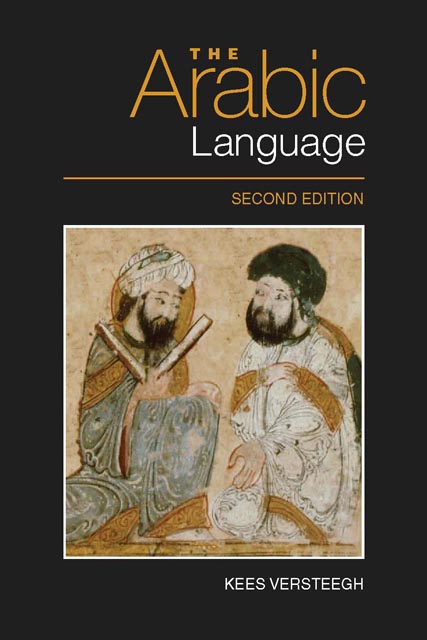Book contents
- Frontmatter
- Contents
- Preface to First Edition
- Preface to Second Edition
- List of Figures and Maps
- List of Tables
- Note on Transcription and Glossing
- 1 The Study of Arabic in the West
- 2 Arabic as a Semitic Language
- 3 The Earliest Stages of Arabic
- 4 Arabic in the Pre-Islamic Period
- 5 The Development of Classical Arabic
- 6 The Structure of Arabic
- 7 The Arabic Linguistic Tradition
- 8 The Emergence of New Arabic
- 9 Middle Arabic
- 10 The Study of the Arabic Dialects
- 11 The Dialects of Arabic
- 12 The Emergence of Modern Standard Arabic
- 13 Diglossia
- 14 Bilingualism
- 15 Arabic as a Minority Language
- 16 Arabic Pidgins and Creoles
- 17 Arabic as a World Language
- Bibliography
- List of Abbreviations
- Index
6 - The Structure of Arabic
Published online by Cambridge University Press: 18 November 2022
- Frontmatter
- Contents
- Preface to First Edition
- Preface to Second Edition
- List of Figures and Maps
- List of Tables
- Note on Transcription and Glossing
- 1 The Study of Arabic in the West
- 2 Arabic as a Semitic Language
- 3 The Earliest Stages of Arabic
- 4 Arabic in the Pre-Islamic Period
- 5 The Development of Classical Arabic
- 6 The Structure of Arabic
- 7 The Arabic Linguistic Tradition
- 8 The Emergence of New Arabic
- 9 Middle Arabic
- 10 The Study of the Arabic Dialects
- 11 The Dialects of Arabic
- 12 The Emergence of Modern Standard Arabic
- 13 Diglossia
- 14 Bilingualism
- 15 Arabic as a Minority Language
- 16 Arabic Pidgins and Creoles
- 17 Arabic as a World Language
- Bibliography
- List of Abbreviations
- Index
Summary
Introduction
In his treatise on the Arabic language, the grammarianIbn Fāris (d. 395/1005) passionately defends theuniqueness of this language, which, he claims,surpasses all other languages in excellence. Hismain argument is, obviously, that God has chosenthis language for His last revelation, which meansthat it must be superior to all other languages.But, in addition, he sums up a number of traits thatmake Arabic a special language (aṣ-Ṣāḥibī fī fiqh al-luġa, ed. Chouémi,Beirut, 1964, pp. 12ff., 42f.). The richness of theArabic lexicon is far beyond that of otherlanguages. The latter have, for instance, only oneword for ‘lion’ or ‘sword’, whereas Arabic hasdozens of synonyms for them. In addition to thislexical abundance, Arabic has special phonologicalrules to make the language easier to produce(‘lighter on the tongue’): it does not haveconsonant clusters, and through assimilation(iddiġām) adjacentconsonants become more similar to each other. One ofthe things on which the Arabs pride themselves isthe presence of declensional vowels (ʾiʿrāb). Ibn Fāris concedesthat some people claim that the Greek philosophers,too, had a declensional system, but according tohim, this is nonsense (kalām lāyuʿarraju ʿalā miṯlihi): those who makethis claim have simply borrowed grammaticalknowledge from the Arabs and attributed it to theGreeks.
In itself, a strong belief in the superiority of one'sown language is a well-known ‘language myth’(Ferguson 1959c), but in the Arabic context it isfuelled by a belief in the superiority of thereligion. From a more sober perspective, Comrie's(2008) comparison of Arabic with other languages ofthe world brings out a number of features that areindeed relatively rare; although having adeclensional system is not one of them. Hiscomparison is based on the World Atlas of Linguistic Structures(WALS), an inventoryof linguistic features in a database of more than2,500 languages, with an average of 400 languagesper feature. In phonology, Comrie mentions thepresence of a class of pharyngals and, as a negativefeature, the absence of /p/ in Arabic, which ispresent in most of the world's languages. Of specialinterest to general linguists are two other featuresof Arabic: emphasis and the stress system.
- Type
- Chapter
- Information
- The Arabic Language , pp. 85 - 106Publisher: Edinburgh University PressPrint publication year: 2014

